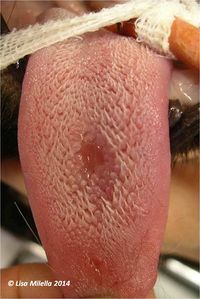Glossitis, Ulcerative
Introduction
This condition can occur in all species, but this article will focus on dogs and cats.
Ulcerative glossitis occurs secondary to other problems such as azotemia, vitamin deficiencies and heavy metal poisoning. Viral causes such as Feline Calicivirus and Feline Herpesvirus (both part of the cat flu complex) as well as panleukopenia and necrotising stomatitis. Calicivirus is found in 7-80% of cases of glossitis in cats and is thought to begin the disease process. Picorna virus and Feline Immunodeficiency Virus are also often found.
Signalment
Ulcerative glossitis is relatively common in cats and quite common in dogs. Animals are often youngish to middle aged if the cause is viral, but are usually older if the condition is caused by azotemia. There is no sex or breed predilection.
Clinical Signs
Signs of drooling and bleeding from the mouth or blood-tinged saliva are commonly seen. The animal may paw at its mouth frequently and be unable to eat although it wants to. There may be resentment in opening of the mouth on a clinical examination. On physical examination, the whole of the back of the mouth is covered in ulcerative granulation tissue and epithelium appears to be lost over the whole of the mucosa. In chronic cases the condition tends to start at angle of jaw (bilateral). Progression is quite slow but over weeks affects whole of back of mouth.
Treatment and Control
The primary cause should be treated in order to treat this condition. Meanwhile, supportive treatment is required such as soft food or a feeding tube in cats. Cats will need to be groomed regularly as they are not able to do this themselves. Antibiotics may be given to prevent secondary infection. The tongue will heal eventually, but takes time and the cat may lose lots of condition.
Also see Glossitis
References
Blood, D.C. and Studdert, V. P. (1999) Saunders Comprehensive Veterinary Dictionary (2nd Edition), Elsevier Science.
Ettinger, S.J, Feldman, E.C. (2005) Textbook of Veterinary Internal Medicine (6th edition, volume 2), W.B. Saunders Company.
Fossum, T. W. et. al. (2007) Small Animal Surgery (Third Edition), Mosby Elsevier.
Merck & Co (2008) The Merck Veterinary Manual (Eighth Edition), Merial.
Sturgess, K. (2003) Notes on Feline Internal Medicine, Blackwell Publishing.
Tutt, C., Deeprose, J. and Crossley, D. (2007) BSAVA Manual of Canine and Feline Dentistry (3rd Edition), British Small Animal Veterinary Association.
| This article was expert reviewed by Lisa Milella BVSc DipEVDC MRCVS. Date reviewed: 13 August 2014 |
| Endorsed by WALTHAM®, a leading authority in companion animal nutrition and wellbeing for over 50 years and the science institute for Mars Petcare. |
